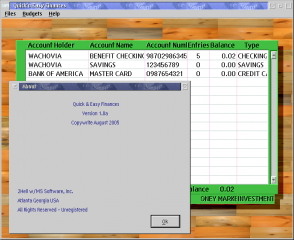The ultimate in personal financial programs for OS/2. This will make the rest of the financial programs here look like they were developed in the early 1990's. Quick & Easy Finance DB source code, in form of dynamic library, released as generic open source, many thanks to Nathan Woodruff!
Quick & Easy Finances
Version:
1.19
Release date:
Wednesday, 17 April, 2019
Categories:
License:
- Shareware
Interface:
- PMShell
- Workplace Shell
Manual installation
Program is distributed as ZIP package: download to temporary directory and unpack to destination folder. You can use also DB/2. See below for download link(s).
Following ones are the download links for manual installation:
| Quick & Easy Finances v. 1.19 (2/12/2025, Nathan Woodruff) | ||
 www.os2developer.com/Qne/QNEv1.19.zip www.os2developer.com/Qne/QNEv1.19.zip |
||
| Quick & Easy Finances v. 1.18 (9/7/2024, Nathan Woodruff) | Readme/What's new |
ChangeLog:
Version 1.18 2024-07-09 Added new feature to be able to bulk transfer items from one account to another. Added the feature to export accounts to either QIF format or CSV format Video of updates to version 1.18 at http://www.videospigot.com/Playvideo.cshtml?vid=76 |
 www.os2developer.com/Qne/qk-v1.18.zip www.os2developer.com/Qne/qk-v1.18.zip |
||
| Quick & Easy Finances v. 1.17 (13/1/2023, Nathan Woodruff) | Readme/What's new |
To use the DB/2 version
1) install DB/2. DB/2 is free for personal use and the latest version for OS/2 can still be found on IBM's website.
2) There is a trick to installing DB/2. It has to be on a HPFS partition of 8Gb or smaller, else it will not install.
3) Once DB/2 is installed edit the file makefinancedb.cmd remove the REM from the first line
4) change the line from FINANCE ON C: to what ever drive you see fit.
5) Save the file.
6) At the command prompt type: makefinancedb
7) There will be errors on the drop statements. Ignore them. They will come in handy next time you need to clear the database.
8) At the command prompt type: Finance
9) Finance.exe is for DB/2
To use Postgres
1) unzip the package to a directory
2) navigate to the pgsql\bin directory
3) At the command line type: initdb
4) if it fails you are on your own, or consult postgres website
5) At the command line type: postmaster
6) in a new command line type: createdb -U postgres FINANCE HOST=localhost
7) When that finishes you should see the command CREATE DATABASE
8) again if it fails, you are on your own.
9) You are now ready to run financegre
To use the the Flat file version with out any database
1) type at the command line: QNE
2) press <enter>
3) have a nice day.
4) evey thing is created for you and all the files are created in a subdirectory flatdb off the current directory
----------------------------------------------------------------------
Fixed an out of order import from .QIF files on the Flat file version that will incorrectly add to register totals instead of subtracting from register totals. Added a "Recalculate" option to the right click popup menu in the Accounts window to recalculate totals and balances for individual accounts. |
 www.os2developer.com/Qne/qk-v1.17.zip www.os2developer.com/Qne/qk-v1.17.zip |
||
| Quick & Easy Finances v. 1.15 (28/6/2020, Nathan Woodruff) | Readme/What's new |
To use the DB/2 version
1) install DB/2. DB/2 is free for personal use and the latest version for OS/2 can still be found on IBM's website.
2) There is a trick to installing DB/2. It has to be on a HPFS partition of 8Gb or smaller, else it will not install.
3) Once DB/2 is installed edit the file makefinancedb.cmd remove the REM from the first line
4) change the line from FINANCE ON C: to what ever drive you see fit.
5) Save the file.
6) At the command prompt type: makefinancedb
7) There will be errors on the drop statements. Ignore them. They will come in handy next time you need to clear the database.
8) At the command prompt type: Finance
9) Finance.exe is for DB/2
To use Postgres
1) unzip the package to a directory
2) navigate to the pgsql\bin directory
3) At the command line type: initdb
4) if it fails you are on your own, or consult postgres website
5) At the command line type: postmaster
6) in a new command line type: createdb -U postgres FINANCE HOST=localhost
7) When that finishes you should see the command CREATE DATABASE
8) again if it fails, you are on your own.
9) You are now ready to run financegre
To use the the Flat file version with out any database
1) type at the command line: QNE
2) press <enter>
3) have a nice day.
4) evey thing is created for you and all the files are created in a subdirectory flatdb off the current directory |
 hobbes.nmsu.edu/download/pub/os2/apps/money/qk.zip hobbes.nmsu.edu/download/pub/os2/apps/money/qk.zip |
Record updated last time on: 05/12/2025 - 19:38

This work is licensed under a Creative Commons Attribution 4.0 International License.

Add new comment